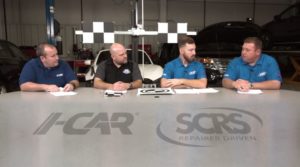
I-CAR-SCRS videos dissect how new courses, tech, OEM actions can impact body shops
By onAnnouncements | Associations | Business Practices | Education | Market Trends | Repair Operations | Technology
Two new videos released by the Society of Collision Repair Specialists and I-CAR on Wednesday showcase the training organization’s nine new vehicle technology courses but largely examine what the underlying subject matter could mean for your shop.
SCRS board member Michael Bradshaw (K&M Collision) and Vice Chairman Brett Bailey (A&B CARSTAR) shared a collision repairer’s perspective in the discussion with I-CAR curriculum and product development director Josh McFarlin and I-CAR industry technical relations director Jason Bartanen.
It’s an engaging and informative conversation that SCRS on Tuesday encouraged shop staff to watch together.
“The video is produced in two segments, with the hopes they can serve as a resource that you can share with your staff in time frames that won’t impede your operation,” SCRS wrote in a news release. “We envision the videos being shared over a team lunch, or perhaps as a full-shop viewing at the close of day. These videos are intended for owners, office staff, technical staff, and anyone in your organization whose job is impacted by understanding and identifying changing technology. …
“Both SCRS and I-CAR encourage this content to be shared as a resource. The industry is made stronger through increased understanding of the changing technology ahead. After you watch, take a moment to pass along to your staff, your colleagues, and even your competitors.”
The changing technology and the need to reference OEM repair procedures to fix it correctly lies at the heart of the nine courses announced last year (a tenth on the Ford Expedition and Lincoln Navigator has also been announced) and of the discussion filmed in November 2017. The conversation regarding “Vehicle Technology and Trends 2018,” the latest version of an annual I-CAR series, shows just how universal yet vehicle-specific automotive structural and electronic technology has become and should indirectly demonstrate to repairers why they need OEM instructions and I-CAR training.
Bailey observed that the collision repair industry five years ago would have deemed certain vehicle engineering as unlikely to ever impact cars fixed by the average repairer. Today, he noted, “these cars are here,” featuring technology like aluminum, rivet bonding and higher-strength steels.
“It’s your everyday vehicles,” Bradshaw said. A shop might have in the past have written off different joining methods, electrification or advanced driver assistance systems as “ultra-high-end cars” or niche brands like Tesla, believing they didn’t fix such cars, he said.
“If you don’t fix those cars, I don’t know what kind of cars you’re fixing,” Bradshaw said.
Even a steel car could be “just as technical” as an aluminum vehicle, he said.
Bartanen said that for many repairers, the vehicle technology and trends class offers “a lot of ‘huh, I didn’t know that.'”
McFarlin asked just how common advanced vehicle technology had become. Bradshaw, whose shop has 17 certifications ranging from mainstream domestics to European luxury brands, estimated it was “90-plus percent” of his repair orders.
He said it used to be “somewhat of a one-size-fits-all” scenario when it came to equipment and other shop items, but “it’s much more vehicle-specific.” Working on vehicles from the past three years, a repairer would constantly encounter instances where “you can’t just pull a piece of equipment out and go to work” — for example, a welding machine must be constantly reset and the wire changed from vehicle to vehicle, according to Bradshaw.
Bailey said his Kansas City, Mo.-based shop does more than a dozen F-150s each week, an apparent reference to the aluminum model which debuted in 2015. He said that while not many might be from the 2018 model year, much of the technology can be found on the more common 2016 and 2017 editions.
Bailey also cited the ultra-high-strength steel door ring of a 2018 Honda Odyssey and a large heads-up display on an unspecified Lexus as examples of technology a shop might encounter.
When you consider that Lexus, Bailey said, “vehicle-specific training is where it’s at and where as an industry we’ve got to be”
Convinced? Check out the videos here and here and what McFarlin described as the nine, hour-long “to-the-point” online courses here.
“By keeping an eye on the latest trends, we hope that the industry embraces the importance of ongoing training and continual skill development,” SCRS wrote.
More information:
“I-CAR and SCRS Release New Videos”
Society of Collision Repair Specialists, Jan. 17, 2018
I-CAR 2018 vehicle technology courses
Images:
Two new videos released by the Society of Collision Repair Specialists and I-CAR on Wednesday showcase nine new vehicle technology courses but largely examine what the underlying subject matter could mean for your shop. From left, I-CAR curriculum and product development director Josh McFarlin and I-CAR industry technical relations director Jason Bartanen appeared along with SCRS board member Michael Bradshaw (K&M Collision) and Vice Chairman Brett Bailey (A&B CARSTAR). (Screenshot from I-CAR and SCRS video)
Two new videos released by the Society of Collision Repair Specialists and I-CAR on Wednesday showcase nine new vehicle technology courses. (Screenshot from I-CAR and SCRS video)


